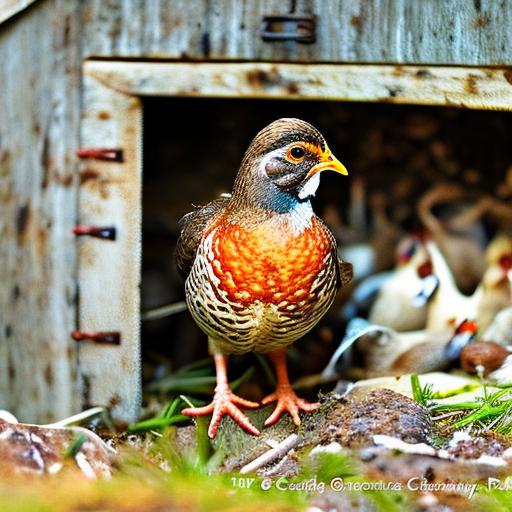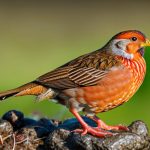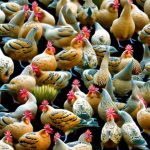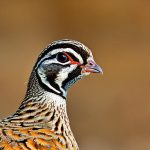When it comes to choosing the right quail pen for chickens, there are a few key factors to consider. First and foremost, it’s important to select a pen that is large enough to accommodate the number of chickens you plan to keep. The pen should provide ample space for the chickens to move around, stretch their wings, and engage in natural behaviors such as scratching and dust bathing. Additionally, the pen should be sturdy and secure, with a roof or cover to protect the chickens from predators and the elements.
Another important consideration when choosing a quail pen for chickens is the material from which it is constructed. While there are many options available, including wood, metal, and plastic, it’s important to select a material that is durable and easy to clean. Additionally, the pen should have good ventilation to ensure that the chickens have access to fresh air and that moisture and odors are able to escape.
In addition to size, construction, and material, it’s also important to consider the layout and design of the quail pen. The pen should include areas for roosting, nesting, and feeding, as well as access to fresh water. It’s also a good idea to include some form of enrichment, such as perches or toys, to keep the chickens entertained and engaged. Ultimately, the right quail pen for chickens will provide a safe, comfortable, and stimulating environment for your feathered friends.
Key Takeaways
- Choose a quail pen with appropriate size and features for chickens to thrive
- Provide enough space and shelter to ensure the comfort and safety of the chickens
- Ensure a consistent supply of food and clean water for the chickens in the quail pen
- Implement measures to protect the chickens from predators and other potential threats
- Regularly clean and maintain the quail pen to promote the health and hygiene of the chickens
- Monitor the health and well-being of the chickens and seek veterinary care when necessary
- Introduce chickens to the quail pen environment gradually and monitor their integration process
Providing Adequate Space and Shelter for Chickens
When it comes to providing adequate space and shelter for chickens in a quail pen, there are a few key considerations to keep in mind. First and foremost, it’s important to ensure that the pen is large enough to accommodate the number of chickens you plan to keep. Chickens need plenty of space to move around, stretch their wings, and engage in natural behaviors such as scratching and dust bathing. As a general rule of thumb, each chicken should have at least 4 square feet of space in the pen.
In addition to providing ample space, it’s also important to ensure that the quail pen provides adequate shelter for the chickens. This includes protection from predators, such as raccoons, foxes, and birds of prey, as well as shelter from the elements, such as rain, wind, and extreme temperatures. The pen should have a solid roof or cover to provide protection from above, as well as secure walls or fencing to prevent predators from gaining access.
It’s also important to provide comfortable roosting and nesting areas for the chickens within the pen. This can include perches for roosting at night, as well as nesting boxes or areas where the chickens can lay their eggs in privacy. Ultimately, providing adequate space and shelter for chickens in a quail pen is essential for their health, well-being, and overall happiness.
Feeding and Watering Chickens in a Quail Pen
Feeding and watering chickens in a quail pen is an essential part of caring for these feathered friends. When it comes to feeding, it’s important to provide a balanced diet that meets the nutritional needs of the chickens. This can include a commercial chicken feed that is formulated specifically for their age and stage of life, as well as access to fresh fruits and vegetables, grains, and protein sources such as mealworms or crickets.
In addition to providing a balanced diet, it’s also important to ensure that the chickens have access to fresh water at all times. This can be provided through a waterer or trough that is kept clean and filled with fresh water daily. It’s important to monitor water consumption and refill the waterer as needed to ensure that the chickens stay properly hydrated.
It’s also important to consider the placement of feeders and waterers within the quail pen. These should be positioned in a way that allows all of the chickens to access them easily without crowding or competition. Additionally, it’s important to keep feeders and waterers clean and free of debris to prevent contamination and spoilage. Ultimately, feeding and watering chickens in a quail pen is an essential part of their care and well-being.
Ensuring Safety and Security for Chickens in a Quail Pen
Ensuring safety and security for chickens in a quail pen is essential for protecting them from predators and other potential dangers. One of the most important steps in ensuring safety and security is to construct a sturdy and secure pen with solid walls or fencing that is buried into the ground to prevent digging predators from gaining access. Additionally, the pen should have a roof or cover to protect the chickens from aerial predators such as hawks or owls.
It’s also important to consider additional security measures such as predator-proof locks on doors and windows, as well as motion-activated lights or alarms to deter potential threats. Regular inspections of the pen for signs of wear or damage can also help to identify and address potential security risks before they become a problem.
In addition to protecting against predators, it’s also important to ensure that the quail pen provides a safe environment for the chickens themselves. This includes removing any potential hazards such as sharp objects or toxic plants, as well as ensuring that the pen is well-ventilated and free of drafts or other environmental risks. Ultimately, ensuring safety and security for chickens in a quail pen is essential for their health, well-being, and overall happiness.
Maintaining Cleanliness and Hygiene in the Quail Pen
Maintaining cleanliness and hygiene in the quail pen is essential for preventing disease and promoting the health and well-being of the chickens. One of the most important aspects of maintaining cleanliness is regular cleaning of the pen itself. This can include removing soiled bedding, droppings, and other debris on a regular basis, as well as thoroughly cleaning and disinfecting the pen periodically.
In addition to cleaning the pen itself, it’s also important to keep feeders and waterers clean and free of debris or contamination. This can help to prevent the spread of disease and ensure that the chickens have access to clean food and water at all times.
Another important aspect of maintaining cleanliness in the quail pen is managing waste effectively. This can include composting soiled bedding and droppings to create nutrient-rich fertilizer for your garden or disposing of waste in a responsible manner that minimizes environmental impact.
Ultimately, maintaining cleanliness and hygiene in the quail pen is essential for promoting the health and well-being of the chickens and creating a safe and comfortable environment for them to thrive.
Monitoring the Health and Well-being of Chickens in a Quail Pen

Monitoring the health and well-being of chickens in a quail pen is an essential part of caring for these feathered friends. One of the most important aspects of monitoring their health is observing their behavior on a daily basis. This can include watching for signs of illness or injury, as well as monitoring their eating, drinking, and egg-laying habits.
In addition to observing their behavior, it’s also important to handle the chickens regularly to check for any physical signs of illness or injury. This can include checking their eyes, ears, beak, feathers, legs, and vent for any abnormalities or signs of distress.
Regular health checks by a veterinarian can also help to ensure that any potential health issues are identified and addressed promptly. This can include vaccinations, deworming, and other preventative measures to keep your chickens healthy and happy.
Ultimately, monitoring the health and well-being of chickens in a quail pen is essential for identifying and addressing any potential issues before they become serious problems.
Integrating Chickens into a Quail Pen Environment
Integrating chickens into a quail pen environment can be an exciting and rewarding experience for both you and your feathered friends. One of the most important aspects of integration is introducing new chickens gradually to allow them time to acclimate to their new surroundings and establish a pecking order within the flock.
It’s also important to provide plenty of hiding spots and escape routes within the pen to allow new chickens to retreat if they feel threatened by more dominant members of the flock. This can include providing plenty of perches, hiding spots, and areas with visual barriers such as plants or structures.
Additionally, it’s important to monitor the behavior of the flock closely during integration to ensure that there is no excessive aggression or bullying among the chickens. If necessary, you may need to separate aggressive individuals or provide additional resources such as food and water stations to reduce competition.
Ultimately, integrating chickens into a quail pen environment can be a rewarding experience that allows your feathered friends to thrive in a social and stimulating environment. With careful planning and monitoring, you can create a harmonious flock that enjoys all the benefits of life in a quail pen.
If you’re considering keeping chickens in a quail pen, you may also be interested in learning about the types of vegetables that quails eat. Understanding their dietary needs can help ensure their health and well-being. Check out this informative article on what vegetables do quails eat to discover more about providing a balanced diet for your quails.
FAQs
What are the benefits of keeping chickens in a quail pen?
Keeping chickens in a quail pen can provide several benefits, including protection from predators, efficient use of space, and the ability to easily move the pen to different areas of the yard for fresh foraging opportunities.
What should be considered when setting up a quail pen for chickens?
When setting up a quail pen for chickens, it’s important to consider the size of the pen, the materials used for construction, ventilation, and access to food and water. Additionally, providing adequate protection from predators is crucial.
What are some important factors to consider for the health and well-being of chickens in a quail pen?
Some important factors to consider for the health and well-being of chickens in a quail pen include providing proper ventilation, access to clean water and nutritious food, protection from extreme weather conditions, and regular cleaning and maintenance of the pen.
What are some common challenges of keeping chickens in a quail pen?
Common challenges of keeping chickens in a quail pen may include managing waste buildup, preventing overcrowding, and protecting the chickens from predators. Additionally, ensuring proper ventilation and maintaining cleanliness can also be challenging.
What are some tips for maintaining a clean and healthy quail pen for chickens?
To maintain a clean and healthy quail pen for chickens, it’s important to regularly remove waste, provide clean bedding, and ensure proper ventilation. Additionally, regularly inspecting the pen for any signs of damage or wear can help prevent potential health issues for the chickens.
Meet Walter, the feathered-friend fanatic of Florida! Nestled in the sunshine state, Walter struts through life with his feathered companions, clucking his way to happiness. With a coop that’s fancier than a five-star hotel, he’s the Don Juan of the chicken world. When he’s not teaching his hens to do the cha-cha, you’ll find him in a heated debate with his prized rooster, Sir Clucks-a-Lot. Walter’s poultry passion is no yolk; he’s the sunny-side-up guy you never knew you needed in your flock of friends!







